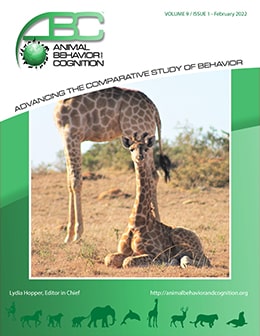Vol 9, Issue 1, February 2022
Investigating Sex Differences in Genetic Relatedness in Great-tailed Grackles in Tempe, Arizona to Infer Potential Sex Biases in Dispersal
Citation
Sevchik, A., Logan. C. J., McCune, K. B., Blackwell, A., Rowney, C., & Lukas, D. (2022). Investigating sex differences in genetic relatedness in great-tailed grackles in Tempe, Arizona to infer potential sex biases in dispersal. Animal Behavior and Cognition, 9(1), 37-52. https://doi.org/10.26451/abc.09.01.04.2022
Abstract
In most bird species, females disperse prior to their first breeding attempt, while males remain close to the place they hatched. While explanations for such female bias in natal dispersal have focused on the resource-defense based monogamous mating system that is prevalent in most birds, the factors shaping dispersal decisions are often more complex. Studying species with different social and mating systems can help illuminate the various factors shaping sex biased dispersal. Here, we use genetic approaches to determine whether females and/or males disperse in great-tailed grackles (Quiscalus mexicanus), which have a mating system where the males hold breeding territories that multiple females might choose to place their nest in, but females forage independently of these breeding territories across a wider area. We find that for individuals caught at a single site in Arizona, (i) the average relatedness among all female dyads, but not of males, is higher than average relatedness among other individuals at the site; (ii) that female close relatives are found within shorter distances from each other than pairs of unrelated females, but male close relatives at larger distances than pairs of unrelated males; and (iii) we find a decline in relatedness with increasing spatial distances for females, but not for males. Our findings show that great-tailed grackles offer opportunities to understand how divergent social and mating systems might shape natal philopatry and dispersal, given their reversal of the usual sex-bias in dispersal with females associating with genetic relatives while males are not.
Keywords
Sex biased dispersal, Genetic relatedness, Mating system, Bird
